What is Baltimore City CAMP
The Critical Area Management Program
The Chesapeake Bay Critical Area Law was created by the Maryland General Assembly on June 1, 1984, to protect the Chesapeake Bay and its tributaries, while fostering more environmentally sensitive development in areas near the shoreline. The law was created in response to national research studies documenting declining water quality and productivity in the Bay. These findings were linked to increased levels of pollutants, nutrients and toxics in the Bay ecosystem. Among other things, the law gave local governments the authority to implement the program and established the Chesapeake Bay Critical Area Commission to establish statewide rules and guidelines.
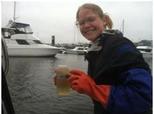 The City of Baltimore has a unique set of guidelines for adhering to the Critical Area requirements. These are published in the Baltimore City Critical Area Management Program (CAMP) Manual and are administered by the Department of Planning. The goals of the City’s program are to improve water quality, conserve and restore habitat, and promote a more attractive and sustainable environment for Baltimore’s citizens. |
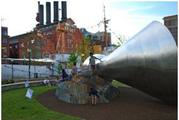 In many cases, the requirements of the CAMP can be met through on-site
practices like planting trees and shrubs, or removing impervious
surfaces. Where the requirements cannot be met on site, mitigation
can occur off-site, at a different location in the critical area.
|

For example, the green elements of Pierce’s Park, a children’s park just
opened near Pier V in the Inner Harbor, was funded in part by off-site CAMP
mitigation funds from the creation of the Dick’s dining pier nearby.
Such off-site mitigation is not always possible, however, because
approximately 40% of Baltimore’s waterfront is composed of bulk heads, and 80%
of the waterfront is zoned industrial. In these cases, developers
may be allowed to pay into the CAMP Offset Fee Fund, managed by the Department
of Planning.
|
What do CAMP Offset Fees Fund?
The Baltimore City CAMP Offset Fee Fund may be used for
activities that support the goals of CAMP, but their use must first be approved
by the state’s Critical Area Commission.
In 2011, CAMP Offset Fee Fund monies supported a variety of programs and
projects, including:
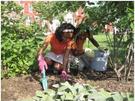
In 2011, Critical
Area funds supported six “BRANCHES” green jobs teams of young adults at four
city public high schools and two public housing sites. The teams received job training in watershed
conservation and restoration, installed and maintained greening projects at the
sites where they worked, and went on ecology-themed field trips. Through the program, 286 trees, 210 shrubs,
and more than 2,000 perennials were planted.
|

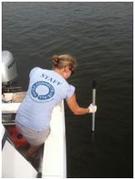
Blue Water Baltimore collected bacteria samples bi-weekly at
30 sampling stations in the Northwest and Middle Branches of the Baltimore
Harbor. Samples were then delivered to the Department of Health and Mental
Hygiene for analysis. Understanding the
state of our water is a crucial step to getting it cleaned up. If you are curious about the results, click here for more info.
|
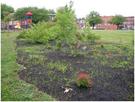
Working at four schools, Blue Water Baltimore supported the
removal of 0.9 acres of concrete and asphalt and the installation of 1,870
square feet of rain
gardens. All four schools engaged
their students in the work, and each school was provided with maintenance
manuals and educational signage to help them make the most of their new, green
schoolyards.
|
For 2012, the Department of Planning has submitted a request
to the Critical Area Commission to use CAMP Offset Fee Fund monies to support Tree
Baltimore’s urban tree canopy goals by working with the U.S. Forest Service to
support an inventory of trees in Baltimore right-of-ways, and to plant almost
150 trees during the next planting cycle.
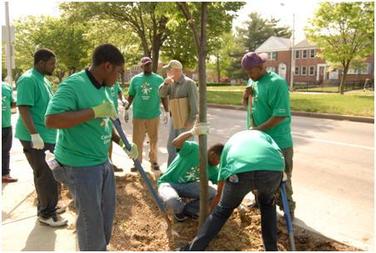
Youth Environmental
Leadership Booming in Baltimore
The Baltimore Sustainability Plan emphasizes the need to
consider the impacts of our plans, policies and programs on future generations. It is not about those of us making decisions
now – it is about leaving our children and future generations the city that
they deserve. To do that, we must
involve the next generation in our sustainability efforts. Giving them an active stake in the programs
and an understanding of the issues greatly enhances the potential for the
long-term success of this important work.

The Baltimore Sustainability Plan was written with
significant youth input and recognizes the need for ongoing youth
participation. Of the four major goals
in the Education & Awareness section of the plan, the first two call on us
to “Turn every school in Baltimore City into a green school” and “Ensure all
city youth have access to environmental stewardship programs and information.”
One of our most successful initiatives to achieve these
goals has been the Green Healthy Smart City Schools Challenge. Launched in 2010, the Challenge provides
$1,000 grants to “Green Teams” of students and adult advisors at Baltimore
City’s public schools for projects related to sustainability, energy, and
healthy food. The program is operated in
partnership with the Baltimore City Public School (BCPS) System, Baltimore
Community Foundation, and Baltimore Energy Challenge, with funding support from
Constellation Energy, Kaiser Permanente, and a variety of smaller institutional
and individual donors.
|
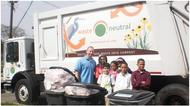
The Challenges are driven by students. In order to apply, schools must submit
signatures from at least five students and one adult advisor who pledge to
serve on a Green Team. The Green Team
members are responsible for coming up with their project concept, timeline, and
budget. If awarded funds, Green Team members are then responsible for
implementing and reporting on their projects, and are invited to present their
results at an end-of-year celebration each spring. Projects funded through the program have
included vegetable gardens, rainwater collection systems, DIY energy audits,
recycled art shows, cafeteria composting projects, and many, many more creative
and transformational ideas.
|
 Participation in the Challenges has grown dramatically over
the past three years, from 16 schools in 2010, to 37 schools in 2011, and 54
schools in 2012. In total, the program
has provided grants totaling $67,414, with more than a third of all Baltimore
City public schools participating since 2010.
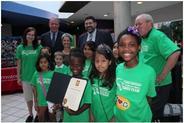
The big finish for the program was the Green Healthy Smart
Challenges Celebration, held at the National Aquarium on March 31, 2012. More than 300 students, teachers, family
members and other supporters showed up to celebrate the students’ accomplishments. BCPS CEO Dr. Andres Alonso presented each
Green Team with a Mayoral Certificate of Appreciation for their work and for
making their schools and communities healthier, greener, smarter places to
live.
To check out great footage of the Celebration, courtesy of
City Schools, go here
and scroll down to the video entitled “ Green, Healthy, Smart.”
|
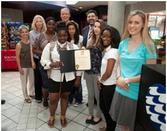 In addition to the Challenges, young environmental leaders
in Baltimore have been participating in the Baltimore Green Schools
Network, attending summits held by Outdoor
Nation , winning funds for Baltimore-based programs, and taking part in a
variety of other amazing projects and programs!
For more on the upcoming 2013 Challenge grants, or on other ways to get
involved, contact Abby Cocke at abby.cocke@baltimorecity.gov
or 410-396-1670. |
|